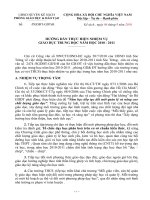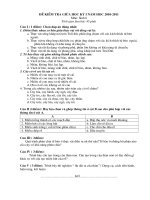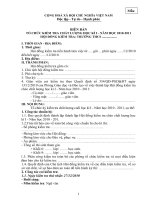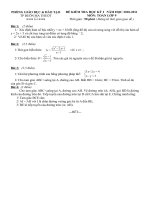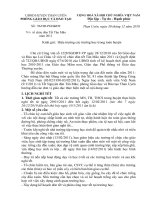neuromuscular disorders treatment and management, 2011, pg
Bạn đang xem bản rút gọn của tài liệu. Xem và tải ngay bản đầy đủ của tài liệu tại đây (37.86 MB, 466 trang )
Neuromuscular Disorders:
Treatment and Management
Neuromuscular Disorders:
Treatment and Management
Tulio E. Bertorini, MD
Professor of Neurology and Pathology
University of Tennessee, Center for the Health Sciences, Memphis
Chief of Neurology, Methodist University Hospital
Director, Wesley Neurology Clinic and Muscular Dystrophy and ALS Clinic
Memphis, Tennessee
1600 John F. Kennedy Boulevard
Suite 1800
Philadelphia, PA 19103-2899
NEUROMUSCULAR DISORDERS: TREATMENT AND MANAGEMENT ISBN: 978-1-4377-0372-6
Copyright # 2011 by Saunders, an imprint of Elsevier Inc. All rights reserved.
No part of this publication may be reproduced or transmitted in any form or by any means, electronic or mechanical,
including photocopying, recording, or any information storage and retrieval system, without permission in writing
from the publisher. Details on how to seek permission, further information about the Publisher's permissions
policies and our arrangements with organizations such as the Copyright Clearance Center and the Copyright Licensing
Agency, can be found at our website: www.elsevier.com/permissions.
This book and the individual contributions contained in it are protected under copyright by the
Publisher (other than as may be noted herein).
Notices
Knowledge and best practice in this field are constantly changing. As new research and experience broaden our
understanding, changes in research methods, professional practices, or medical treatment may become necessary.
Practitioners and researchers must always rely on their own experience and knowledge in evaluating and using
any information, methods, compounds, or experiments described herein. In using such information or methods
they should be mindful of their own safety and the safety of others, including parties for whom they have a
professional responsibility.
With respect to any drug or pharmaceutical products identified, readers are advised to check the most current
information provided (i) on procedures featured or (ii) by the manufacturer of each product to be administered, to
verify the recommended dose or formula, the method and duration of administration, and contraindications. It is
the responsibility of practitioners, relying on their own experience and knowledge of their patients, to make
diagnoses, to determine dosages and the best treatment for each individual patient, and to take all appropriate
safety precautions.
To the fullest extent of the law, neither the Publisher nor the authors, contributors, or editors, assume any liability
for any injury and/or damage to persons or property as a matter of products liability, negligence or otherwise, or from
any use or operation of any methods, products, instructions, or ideas contained in the material herein.
Library of Congress Cataloging-in-Publication Data
Neuromuscular disorders: treatment and management / [edited by] Tulio E. Bertorini. —1st ed.
p. ; cm.
Includes bibliographical references.
ISBN 978-1-4377-0372-6
1. Neuromuscular diseases. I. Bertorini, Tulio E.
[DNLM: 1. Neuromuscular Diseases—therapy. WE 550 N49443 2010]
RC925.5.N474 2011
616.7
0
44—dc22
2010010083
Acquisitions Editor: Adrianne Brigido
Developmental Editor: Taylor Ball
Design Direction: Lou Forgione
Printed in China
Last digit is the print number: 9 8 7 6 5 4 3 2 1
This work is dedicated to the members of my loving family: to my father,
Nicolas; the memory of my mother, Enriqueta; my wife, Emma; my daughter,
Paola and her husband Jason; my sons, Tulio and Francisco, and their girlfriends,
Stacy and Paulinha; as well as my grandson, Nicolas.
Also, I want to dedicate this book to the families of my collaborators and particularly to the
memory of my friend, excellent clinician and researcher,
Lisa Krivickas, MD, who collaborated in this book and who recently passed away.
Preface
Recent advances in the understanding of the genetics and basic
mechanisms of neuromuscular diseases have been both rapid and
spectacular. Furthermore, these advances have resulted in an expan-
sion of the methods used for diagnosis—from routine clinical histo-
logic and electrophysiologic tests to more specific techniques, such as
biochemical and Western Blot analysis, and, most important, molec-
ular genetic testing. These modern techniques have begun to replace
more costly and painful procedures for some patients.
Innovations in the field of molecular genetics have led to the
identification of certain protein deficiencies and thus to the design
of replacement therapy for some conditions. Examples include
enzyme replacement with recombinant alpha-glucosidase for Pompe
disease and agalsidase for Fabry disease. Another important advance
in the understanding of neuromuscular disorders has been the recog-
nition of the pathways of the cascade of immune mechanisms of
autoimmune diseases. This understanding allows us to treat these
disorders with newer immunosuppressants and selective monoclonal
antibodies that target specific molecules of this cascade. These
treatments hold promise for better patient care, but more knowledge
of possible adverse effects is needed. At times monoclonal antibodies
have been found to cause autoimmune disorders, further com-
plicating therapy.
Although the goal of our specialty is to find cures or effective
treatments for neuromuscular disorders, the management of symptoms
to improve quality of life is still paramount. The control of pain in the
treatment of dysautonomic symptoms and the management of muscle
hyperactivity in the myotonias are examples.
Ambulation and survival can be prolonged with well-planned
rehabilitation programs, orthopaedic surgery, and proper early man-
agement of cardiac, respiratory, and gastrointestinal complications,
particularly in patients with motor neuron diseases and muscular
dystrophy. Prolonged survival has changed the care of these patients.
For example, in the past patients with Duchenne muscular dystro-
phy generally died of respiratory failure before they developed symp-
tomatic cardiac disease; now they are living longer and require
aggressive treatment of their cardiac complications to further prolong
their lives.
Many excellent textbooks and treatises dedicated to the under-
standing of the basic mechanisms of clinical and laboratory diagnoses
of neuromuscular diseases also include discussions of treatment but
this information is not comprehensive. In this text we aim to cover
the current treatment and management of these subjects and to dis-
cuss promising experimental therapies. Also included are discussions
of the prevention and treatment of neuromuscular complications of
medical conditions and surgery.
The introductory chapter is a brief overview of the approach to
diagnosis and treatment in patients with neuromuscular disease—
information that we hope will be helpful to young clinicians. The
next several chapters discuss complications of neuromuscular dis-
orders and their general management, such as rehabilitation, ortho-
paedic surgery, and cardiac, gastrointestinal, and respiratory care,
as well as the treatment of painful neuropathy and dysautonomia.
The balance of the chapters cover specific diseases as well as the
basic mechanisms of these disorders.
The information in each chapter is intended to complement that
in others, although occasionally there are minor repetitions. When
possible, evidence-based treatment recommendations are given,
particularly for the more common conditions, though we emphasize
that the treatment of all patients should be individualized. For less
common disorders, for which controlled trials have not yet been
published, recommendations are based on published information
and the authors’ experience.
I am honored and grateful for the collaboration of an excellent
group of renowned specialists. They have generously contributed
their time and expertise to make what we hope is a textbook that
is useful for all physicians who care for patients with neuromuscular
disorders.
Tulio E. Bertorini, MD
vii
Acknowledgments
For their untiring editorial assistance, I want to express my sincere
appreciation to Rachel Young, RN, BS, BSN, my research coordina-
tor, and to Kay Daugherty, medical editor of the Campbell
Foundation.
I thank Mariallen Shadle for her work on the excellent histologic
slides and Cindy Culver for transcription of the manuscripts.
The compilation of my Introduction was completed with the
help of Rachel Young, Mariallen Shadle, and Kay Daugherty.
Recognition is extended to Taylor Ball and Adrianne Brigido of
Elsevier and to Peggy Gordon of P. M. Gordon Associates.
My appreciation is also extended to Wesley Neurology Clinic,
Methodist Hospitals of Memphis, and The University of Tennessee
Health Science Center for continuous support.
I wish in particular to express my gratitude to the authors and
collaborators of the various chapters of this work, with a special
thanks to their families, as they have sacrificed their time together
to participate in the preparation of this book. I also wish to thank
Drs. Genaro Palmieri, Abbas Kitabchi, and Cesar Magsino for their
insightful comments regarding Chapter 20, on endocrine disorders.
Finally, to all of our patients, whom we hope will benefit from
the knowledge we continue to gain.
Tulio E. Bertorini, MD
ix
Contributors
Bassam A. Bassam, MD
Professor of Neurology
Director of Neuromuscular and EMG Laboratory
University of South Alabama
College of Medicine
Attending and Professor of Neurology
University of South Alabama Medical Center
Mobile, Alabama
Chapters 10 and 20
Tulio E. Bertorini,
MD
Professor of Neurology and Pathology
University of Tennessee, Center for the Health Sciences, Memphis
Chief of Neurology, Methodist University Hospital
Director, Wesley Neurology Clinic and Muscular Dystrophy
and ALS Clinic
Memphis, Tennessee
Chapters 1, 7, 10, and 20
William W. Campbell, Jr.,
MD
Professor and Chairman
Uniformed Services University of Health Sciences
Chief, Clinical Neurophysiology
Walter Reed Army Medical Center
Bethesda, Maryland
Chapter 16
Vinay Chaudhry,
MD
Professor of Neurology
Vice Chair, Clinical Affairs
Johns Hopkins University School of Medicine
Baltimore, Maryland
Chapter 13
Marinos C. Dalakas,
MD
Professor, Clinical Neurosciences
Chief, Neuromuscular Diseases Service
Imperial College, London
Hammersmith Hospital Campus
London, England
Chief, Neuroimmunology Unit
Department of Pathophysiology
University of Athens Medical School
Athens, Greece
Chapter 21
Marcus Deschauer,
MD
Neurologische Klinik
Universitat Halle-Wittenberg
Halle, Germany
Chapter 22
Diana M. Escolar,
MD
Associate Professor of Neurology
John Hopkins School of Medicine
Center for Genetic Muscle Disorders
Kennedy Krieger Institute
Baltimore, Maryland
Chapter 19
Christopher H. Gibbons,
MD, MMSc
Assistant Professor of Neurology
Harvard Medical School
Staff Neurologist
Beth Israel Deaconess Medical Center
Director, Diabetic Neuropathy Clinic
Joslin Diabetes Center
Boston, Massachusetts
Chapter 5
Daniel M. Goodenberger,
MD
Professor and Chairman
Department of Medicine
University of Nevada School of Medicine
Las Vegas, Nevada
Chapter 2
Nivia Hernandez-Ramos,
MD
Neuromuscular Medicine Program
Division of Neurology
University of Puerto Rico School of Medicine
San Juan, Puerto Rico
Chapter 15
xi
Susan T. Iannaccone, MD
Jimmy Elizabeth Westcott Distinguished Chair
in Pediatric Neurology
Professor of Neurology and Pediatrics
University of Texas Southwestern Medical Center
Director of Pediatric Neurology
Children's Medical Center
Chair, Section on Child Neurology
American Academy of Neurology
Dallas, Texas
Chapter 12
Cristian Ionita,
MD
Assistant Professor of Pediatrics
University of Arkansas for Medical Sciences
Director of Neuromuscular Diagnostic Clinic
Arkansas Children's Hospital
Little Rock, Arkansas
Chapter 12
Mohammad K. Ismail,
MD
Program Director
Gastroenterology Fellowship and Training
University of Tennessee, Memphis
Chief of Gastroenterology
Methodist University Hospital
Memphis, Tennessee
Chapter 4
Lisa S. Krivickas,
MD
{
Associate Professor of Physical Medicine and Rehabilitation
Harvard Medical School
Associate Chair of Academic Affairs
Associate Chief of Physical Medicine and Rehabilitation
Massachusetts General Hospital
Boston, Massachusetts
Chapter 8
Robert T. Leshner,
MD
Professor of Neurology and Pediatrics
Children's National Medical Center
George Washington University
Washington, DC
Chapter 19
Yingjun David Li,
MD
Consulting Neurologist
Methodist Le Bonheur Healthcare
Memphis, Tennessee
Chapter 10
Thomas E. Lloyd,
MD, PhD
Assistant Professor
Department of Neurology
The Johns Hopkins School of Medicine
Baltimore, Maryland
Chapter 13
Catherine Lomen-Hoerth,
MD, PhD
Associate Professor of Neurology
University of California, San Francisco
San Francisco, California
Chapter 11
Carlos A. Luciano,
MD
Professor of Neurology
Director, Neuromuscular Medicine Program
Division of Neurology
University of Puerto Rico School of Medicine
San Juan, Puerto Rico
Chapter 15
Daniel L. Menkes,
MD
Director of Clinical Neurophysiology
University of Connecticut Health Center
Farmington, Connecticut
Chapter 6
Christopher W. Mitchell,
MD
Neurologist
West Tennessee Neurosciences
Jackson, Tennessee
Chapters 7 and 10
Pushpa Narayanaswami,
MD
Instructor of Neurology
Division of Neuromuscular Diseases
Department of Neurology
Harvard Medical School
Beth Israel Deaconess Medical Center
Boston, Massachusetts
Chapter 17
Peter O'Carroll,
MD
Fellow, Clinical Neurophysiology
The University of Tennessee Health Science Center
Memphis, Tennessee
Chapter 19
Shin J. Oh,
MD
Distinguished Professor of Neurology
Department of Neurology and Pathology
University of Alabama at Birmingham
Birmingham, Alabama
Chapter 18
Nicholas J. Silvestri,
MD
Assistant Professor of Neurology
State University of New York at Buffalo School of Medicine
Staff Neurologist
Erie County Medical Center
Buffalo, New York
Chapter 5
{
Deceased
xii Contributors
Zachary Simmons, MD
Professor of Neurology
The Pennsylvania State University School of Medicine
Director, Neuromuscular Program and ALS Center
Penn State Hershey Medical Center
Hershey, Pennsylvania
Chapter 14
Christopher F. Spurney,
MD
Assistant Professor of Pediatrics
Division of Cardiology
Children's National Heart Institute
Children's National Medical Center
Washington, DC
Chapter 3
Matthias Vorgerd,
MD
Associate Professor of Neurology
Bergmannsheil GmbH
Department of Neurology, Ruhr-University Bochum
Neuromuscular Center
Bochum, Germany
Chapter 22
William C. Warner, Jr.,
MD
Professor, Department of Orthopaedic Surgery
University of Tennessee Center for the Health Sciences
LeBonheur Children's Medical Center
Campbell Clinic, Inc.
Memphis, Tennessee
Chapter 9
Dorothy Weiss,
MD, EdM
Clinical Fellow, Physical Medicine and Rehabilitation
Chief Resident, Spaulding Rehabilitation Hospital
Harvard Medical School
Boston, Massachusetts
Chapter 8
Contributors xiii
